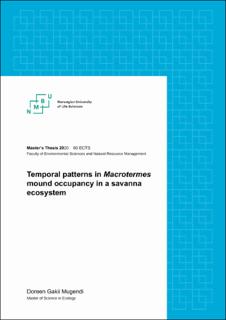| dc.description.abstract | Macrotermes play a central role in the structure and functioning of many savanna ecosystems. However, the patterns they display in occupying the mounds and important mechanisms that support these patterns are not well documented. In this study, I investigated temporal patterns in mound occupancy by Macrotermes Subhyalinus in Lake Mburo National Park, Uganda. The status of 310 active and inactive mounds was investigated over a period of ten years. Collection of data started at the beginning of the study in 2007 and was done twice in 2008 and at the end of the ten-year period in 2016. Change in the number of active mounds was analyzed using Generalized Linear Mixed Models (GLMM). Generalized Linear Model (GLM) is used to test the effect of mound characteristics (size, vegetation cover, geophagy, elevation, proximity to water) on active mounds. Factors (size, vegetation cover, geophagy) characterizing inactive and re-occupied mounds were also compared. Relationships between local rainfall/temperature and active mounds was investigated by correlation analyses. The rainfall/temperature was also analyzed for temporal trends and variability. The present study established that active mounds decreased from about 50% in 2007 and 2008 to only 2% in 2016 (P < 0.0001). However, the surveys in early and late 2008 showed an increasing proportion of active mounds compared to 2007 suggesting a significant decrease occurred after 2008. From the GLM results, soil eating by large herbivores (geophagy) occurred more on active mounds (P < 0.001). Additionally, active mounds were generally less vegetated with about 33.26 ± 16.64 % of their surface covered. The study also established that mounds that became re-occupied by Macrotermes did not differ in size and vegetation cover within 2008 (P = 0.19). Neither, did the size of inactive mounds change significantly after ten years (P = 0.61) suggesting that mounds were protected from erosion and animal damage by the vegetation cover which increased from about 42 ± 19 % in 2007 to 66 ± 32 % in 2016 (P < 0.0001). No significant relationship was found between active mounds and rainfall (r = 0.04, P = 0.16) or temperature (r = -0.038, P = 0.25). The drastic decline of active mounds in the study area was potentially due to predation by aardvarks and/or Doryline ants, which requires further investigation. This study did not find a single factor that determines occupancy of the mounds by Macrotermes thereby suggesting a complex interaction of factors that is likely not restricted by time. More studies on potential factors in the savanna with regular assessments is therefore recommended. | en_US |

